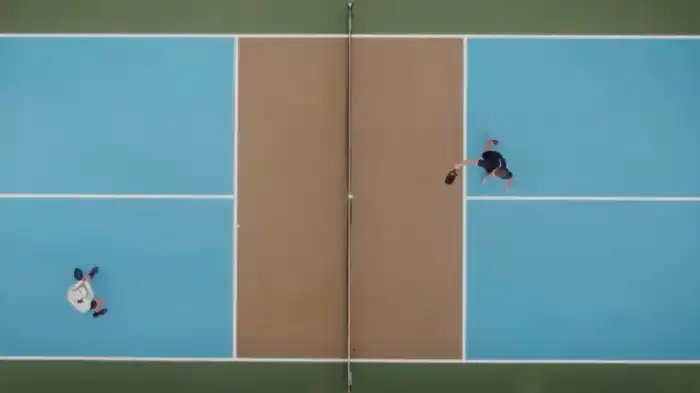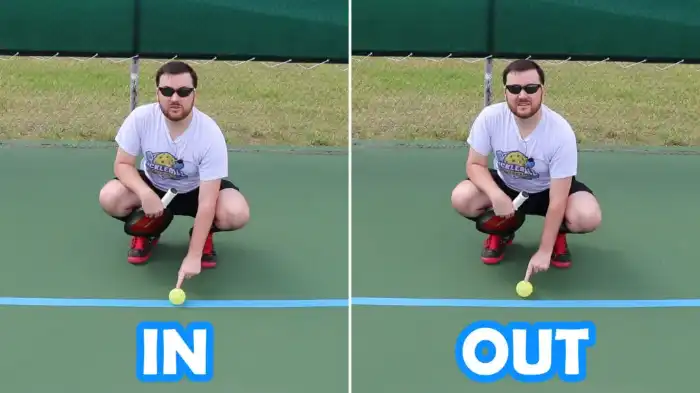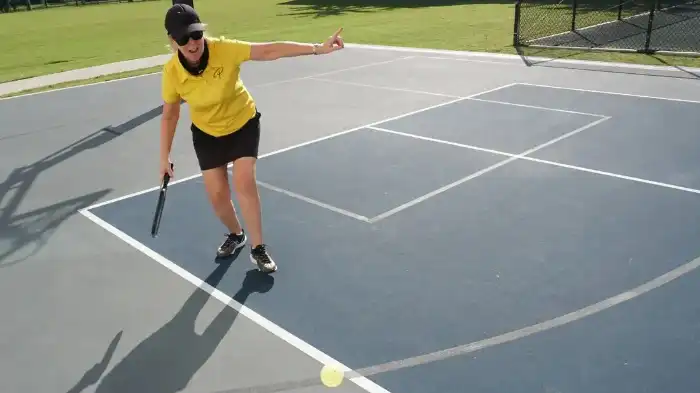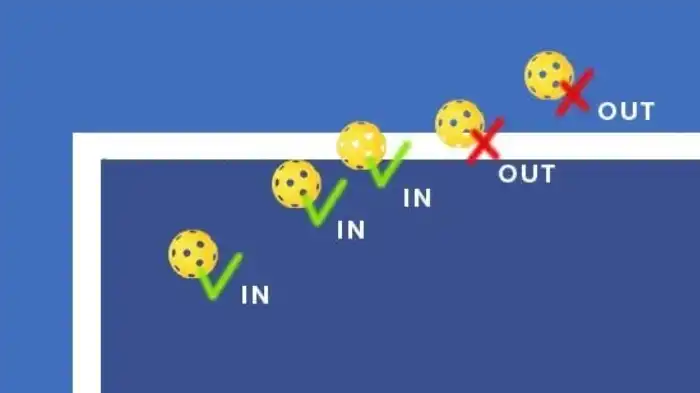Are Lines in or out in Pickleball? That’s the burning question that has sparked countless discussions in the vibrant world of pickleball. As a game that blends finesse, strategy, and precision, the role of lines in pickleball is more than just about defining boundaries. They dictate the flow of the game, impact scoring, and often become a focal point of controversy.
In this blog, we will answer the question given above, delve into the purpose of lines in pickleball, explore controversies related to line calls, examine the role of technology in resolving line call disputes, and provide valuable tips for enhancing the accuracy of line calls in pickleball.
Purpose of Lines in Pickleball
The lines on a pickleball court serve several important purposes, and they play a fundamental role in defining the boundaries and rules of the game. Here are the key purposes of lines in pickleball:
Defining Court Boundaries:
The most basic purpose of the lines in pickleball is to outline the court’s boundaries. These lines create a clear and standardized playing area, ensuring that players know the limits of where the game is played. Without these lines, it would be challenging to determine the court’s size and shape.

Determining In or Out Calls:
Lines are critical for making in or out calls during the game. In pickleball, a shot is considered “in” if it lands on any part of the line and “out” if it lands completely outside the line. This rule applies to serves, shots during rallies, and even when determining the validity of baseline shots. The lines help players and referees make accurate judgments about the location of the ball, which in turn impacts the score and the flow of the game.
Scoring and Serve Rules:
Lines also play a role in determining the serving and receiving positions on the court. The serving area is divided by the centerline, and the service boxes are marked with lines. These lines help players serve from the correct position and follow the serving rules. Additionally, the non-volley zone or “kitchen” has a line that defines its boundaries, which is important for players to know as they cannot volley (hit the ball out of the air) while standing within this zone.
Organization and Structure:
Lines provide a structured and organized layout for the court, ensuring that all games are played on a standardized and fair surface. This consistency is essential for fair competition and helps prevent disputes regarding court dimensions and boundaries.
Fair Play and Sportsmanship:
The lines help promote fair play and sportsmanship in pickleball. Players are expected to make honest line calls, which means accurately determining whether the ball landed in or out. This expectation of fair play encourages good sportsmanship, integrity, and respect for opponents.
Maintaining the Integrity of the Game:
Accurate line calls and adherence to the rules regarding lines are essential for maintaining the integrity of the game. Without clearly defined boundaries and rules related to lines, pickleball would become chaotic and disputes would be common. The lines ensure that the game is played within a well-defined structure, making it enjoyable for all participants.
Are Lines in or Out in Pickleball?
In pickleball, the answer to the question, “Are Lines in or Out in Pickleball?” is relatively straightforward. When a shot or ball lands on any part of the line, it is considered “in.” Conversely, if the ball lands entirely outside the line, it is deemed “out.” This rule is consistent and uniform across all levels of play, from casual games at local courts to competitive tournaments.
This rule is designed to ensure clarity and fairness in the game. It simplifies line calls by eliminating any ambiguity. When a ball touches the line, it’s unambiguously “in,” and when it doesn’t, it’s “out.” This straightforward approach helps to maintain the integrity of the sport and reduces disputes and disagreements on the court.
The “in” or “out” rule applies to various aspects of pickleball, including serves, rallies, and baseline shots. It is not open to interpretation or subjectivity; it’s a fundamental and non-negotiable rule of the game. Players, whether in a casual setting or a competitive match, are expected to uphold this rule as part of their commitment to fair play and sportsmanship.
In summary, lines in pickleball are clearly defined, and the rule is consistent: “in” means any part of the ball touching the line, and “out” means the ball landing entirely outside the line. This rule ensures fairness, simplicity, and the preservation of the game’s integrity.

Controversies Surrounding Line Calls in Pickleball
Controversies surrounding line calls in pickleball are not uncommon and have been a topic of discussion within the pickleball community. These controversies typically arise due to differing interpretations of line calls, the absence of instant replay technology on most pickleball courts, and the competitive nature of the sport. Here are some of the key controversies and challenges surrounding line calls in pickleball:
Subjectivity:
Line calls can be subjective, as they often rely on a player’s judgment. Different players may have varying perspectives on whether a shot was “in” or “out,” leading to disagreements and disputes. These subjective judgments can become sources of tension during games.
Lack of Technology:
Unlike sports such as tennis, where instant replay technology is used to resolve line call disputes, most pickleball courts do not have such technology readily available. This absence of a reliable tool for reviewing line calls can result in disputes that are left to the discretion of players or referees.
Impact on the Game:
Line call controversies can significantly impact the outcome of a game. A disputed line call may change the score or result in a disputed point, which can influence the overall outcome of a match. In competitive play, these disputes can be particularly contentious.
Integrity and Sportsmanship:
Controversial line calls challenge the integrity and sportsmanship of the game. Players are expected to make honest and fair calls, and disputes over line calls can strain the trust and respect between competitors.
Tension and Disagreements:
Tension can arise when there are disputes over line calls. Players may engage in heated discussions, which can disrupt the flow of the game and affect the enjoyment of the sport. These disagreements can be particularly pronounced in competitive matches.
Consistency and Fairness:
Ensuring consistent and fair line calls can be a challenge. Some players may be more conservative in making calls, while others may be more liberal. This lack of uniformity can create inconsistencies and lead to disputes.
Refereeing Challenges:
In competitive matches, referees are often responsible for making final line call decisions. However, referees may also make mistakes or be subject to challenges from players. The interpretation of line calls by referees can lead to their own set of disputes and controversies.
To address these controversies, some players and organizations have called for the use of technology, such as Hawk-Eye systems, to assist in making accurate line calls. Additionally, fostering a culture of sportsmanship, where players prioritize fair play and honest line calls, is crucial in minimizing controversies and ensuring that the focus remains on the game itself rather than disputes.
Tips for Improving Line Calls in Pickleball
Accurate line calls are crucial in maintaining the integrity and sportsmanship of pickleball. To improve your line calls and minimize disputes on the court, consider the following tips:
Positioning:
Proper positioning is essential for making accurate line calls. Stand in a location that provides the best perspective on the ball’s trajectory in relation to the lines. This might require you to move quickly and adjust your position during the point.
Use Visual Aids:
Utilize visual aids to assist in making line calls. The shadow of the ball can be a helpful cue, especially when the sun is at an angle. You can also use the line itself as a reference point to judge the ball’s landing position.
Clear Communication:
If you’re playing doubles, communicate effectively with your partner. Clear verbal or non-verbal signals can help ensure that both players agree on line calls. This can prevent disputes and create a more harmonious partnership.
Maintain Focus:
Stay focused and attentive during rallies. Keep your eyes on the ball, especially when it is near the lines. This concentration can help you make quick and accurate judgments.

Practice:
Practice makes perfect. Spend time practicing your line calls in a friendly setting. Have a partner hit balls near the lines, and make calls to refine your judgment. This can also help you become more confident in your calls.
Confidence and Honesty:
Be confident in your line calls, but also be honest. If you genuinely believe the ball was in or out, make the call without hesitation. Your confidence can influence your opponent’s confidence in your judgment.
Respect Opponents’ Calls:
Just as you expect respect for your line calls, show respect for your opponents’ calls. If they make a call, accept it without dispute. Remember that disputes can disrupt the flow of the game and lead to tension.
Know the Rules:
Familiarize yourself with the official pickleball rules, especially those related to line calls. Knowing the rules will help you make informed calls and avoid disputes. Understanding nuances, such as how a ball touching any part of the line is considered “in,” is crucial.
Stay Calm:
In the event of a disputed line call, stay calm and composed. Engaging in arguments or confrontations can negatively affect the playing environment. If there’s a genuine disagreement, consider replaying the point rather than escalating the dispute.
Be a Good Sport:
Above all, remember that pickleball is about fun, camaraderie, and sportsmanship. Strive to be a good sport and maintain a positive attitude, regardless of the outcome of line calls. Encourage fair play and treat your opponents with respect.
Improving your line calls in pickleball not only contributes to a smoother and more enjoyable game but also reflects your commitment to upholding the principles of fair play and sportsmanship in the sport.
The Role of Technology in Resolving Line Call Disputes in Pickleball
The role of technology in resolving line call disputes in pickleball has gained increasing importance in recent years. Technology provides a more accurate and objective means of determining whether a shot was “in” or “out,” reducing the potential for disputes and promoting fair play.
One of the most prominent technologies used in this context is the Hawk-Eye system, which employs high-speed cameras to track the path of the ball and provide instant replays. This system is currently used in various sports, including tennis and cricket, and has been tested in pickleball as well.
With Hawk-Eye or similar technology, players and referees can review contentious line calls, making the decision-making process more transparent and unbiased. This not only resolves disputes quickly but also adds a level of consistency and reliability to the game.
The introduction of such technology aligns pickleball more closely with other professional sports, offering a fairer and more accurate means of settling line call controversies. While not yet universally available at all pickleball courts, the use of technology in resolving line call disputes is a significant step forward in enhancing the sport’s integrity and reducing the potential for disputes.
Frequently Asked Questions
In casual play, players often rely on their judgment and are generally expected to make honest line calls. In more competitive settings with referees or technology, challenges may be allowed, but it varies based on the rules of the specific game or tournament.
If the ball touches any part of the line, it is considered “in.” The line is considered part of the court, and any contact with it is a valid in-bounds shot.
The basic rules for line calls, such as considering a ball “in” if it touches any part of the line, are consistent. However, specific tournament rules may vary slightly, so it’s essential to familiarize yourself with the rules for each tournament you participate in.
In pickleball, lines are considered “in” if the ball touches any part of the line. This rule is consistent and non-negotiable, ensuring clarity and fairness in the game. The lines serve as clear boundaries, impacting scoring and promoting sportsmanship.
No, in pickleball, the rule is clear: If any part of the ball touches the line, it’s considered “in.” There is no such thing as a shot being partially in or out.
Conclusion
So, are lines in or out in pickleball? The answer is clear: in. In pickleball, the rules are unambiguous – if the ball touches any part of the line, it’s considered “in.” These lines play a vital role in the game, from defining court boundaries to determining scoring and promoting sportsmanship.
Controversies surrounding line calls may persist, but they only emphasize the importance of accurate judgment and good sportsmanship. The introduction of technology like Hawk-Eye offers a promising solution to these disputes, bringing pickleball more in line with other sports where technology aids in accurate decision-making.
As you step onto the pickleball court, remember that the lines are not just boundaries but also guides to fairness and integrity. The game is about camaraderie, strategy, and precision, and the lines help keep it exciting and challenging. So, next time you ask, “Are Lines in or Out in Pickleball?” you’ll know the answer – they’re in, ensuring a fair and fun game for all.

